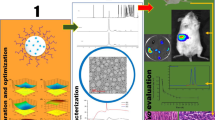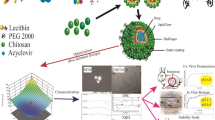Abstract
The present study discusses lactose-acyclovir-N-succinyl chitosan nanoparticles (Lac-N-Suc-CSNP) using lactose as an asialoglycoprotein receptor (ASGPR) ligand for hepatic parenchymatic cells targeting. For this purpose, N-succinyl chitosan nanoparticles (N-Suc-CSNP) were prepared previously by ionotropic gelation method and lactose was conjugated to the free amino terminal group of chitosan. Lactose conjugation with N-Suc-CSNP was confirmed by FT-IR and zeta potential measurements. The Lac-N-Suc-CSNP obtained were characterized for their morphology, particle size, polydispersity index, and zeta potential. The Lac-N-Suc-CSNP showed spherical in shape with 220.3 ± 5.0 nm size range, +4.1 ± 0.2 mV zeta potential, 62.5 ± 1.2 % acyclovir entrapment efficiency and showed 27.3 ± 0.9 % cumulative acyclovir release up to 72 h. The acyclovir concentration from Lac-N-Suc-CSNP was found to be 19.9 ± 1.62 μg/g after 24 h administration revealed remarkably targeting potential to the hepatocytes and keep at a high level during the experiment. These results suggest that Lac-N-Suc-CSNP are potentially vector for hepatocytes targeting.










Similar content being viewed by others
Abbreviations
- ASGPR:
-
Asialoglycoprotein receptor
- N-Suc-CSNP:
-
N-succinyl chitosan nanoparticles
- Lac-N-Suc-CSNP:
-
Lactosaminated-N-succinyl chitosan nanoparticles
- PDI:
-
Poly dispersity index
- FITC:
-
Fluorescein isothiocyanate
- TEM:
-
Transmission electron microscopy
- FT-IR:
-
Fourier-transform infrared spectroscopy
References
Agrawal P, Gupta U, Jain NK (2007) Glycoconjugated peptide dendrimers-based nanoparticulate system for the delivery of chloroquine phosphate. Biomaterials 28:3349–3359
Bhadra D, Yadav AK, Bhadra S, Jain NK (2005) Glycodendrimeric nanoparticulate carriers of primaquine phosphate for liver targeting. Int J Pharm 295:221–233
Borch RF, Bernstein MD, Durst HD (1971) The cyanohydridoborate anion as a selective reducing agent. J Am Chem Soc 93:2897–2904
Calvo P, Remunan-Lopez C, Vila-Jato JL, Alonso MJ (1997) Novel hydrophilic chitosan–polyethylene oxide nanoparticles as protein carrier. J Appl Poly Sci 63:125–132
Griffiths PD (2009) A perspective on antiviral resistance. J Clin Virol 46:3–8
Gulyaev AE, Gelperina SE, Skidan IN, Antropov AS, Kivman GY, Kreuter J (1999) Significant transport of doxorubicin into the brain with polysorbate 80 coated nanoparticles. Pharm Res 16:1564–1569
Jayaseelan S, Suresh S, Sathishkumar G, Sekar V, Perumal P (2010) Bioanalytical method development and validation of lamivudine by RP-HPLC method. Int J Chem Tech Res 2:163–167
Kato Y, Onishi H, Machida Y (2000a) Evaluation of N-succinyl-chitosan as a systemic long circulating polymer. Biomaterials 21:1579–1585
Kato Y, Onishi H, Machida Y (2000b) Biological characteristics of lactosaminated N-succinyl-chitosan as a liver-specific drug carrier in mice. J Control Rel 70:295–307
Kato Y, Onishi H, Machida Y (2003) Application of chitin and chitosan derivatives in the pharmaceutical field. Curr Pharm Biotech 7:303–309
Kauper P, Rossi N, Laue C, Schmitt F, Lagopoulos L, Juillerat L, Wandrey C (2007) Chitosan based nanoparticles for medical applications: stability in physiological environments. Eur Cel Mat 13:3–4
Kawakami S, Yamashita F, Nishikawa M, Takakura Y, Hashida M (1998) Asialoglycoprotein receptor mediated gene transfer using novel galactosylated cationic liposomes. Biochem Biophys Res Commun 252:78–83
Lin WJ, Chen MH (2006) Synthesis of multifunctional chitosan with galactose as a targeting ligand for glycoprotein receptor. Carbohydr Polym 67:474–480
Mandloi DK, Tyagi PK, Rai VK, Dey S, Ashada RK, Mohanraj P (2009) Method development and validation of RP-HPLC in the application of in vitro dissolution study of lamivudine in bulk drug and tablet formulation. J Chem Pharm Res 1:286–296
Mao SJ, Hou SX, He R, Zhang LK, Wei DP, Bi YQ, Jin H (2005) Uptake of albumin nanoparticle surface modified with glycyrrhizin by primary cultured rat hepatocytes. World J Gastroenterol 11:3075–3079
McMahon BJ, Doo E (2009) The natural history of chronic hepatitis B virus infection. Hepatology 49(5):45–55
Mourya VK, Inamdar NN (2008) Chitosan-modifications and applications: opportunities galore. React Funct Polym 68(6):1013–1051
Nimje N, Agarwal A, Saraogi GK, Lariya N, Rai G, Agrawal H, Agrawal GP (2009) Mannosylated nanoparticulate carriers of rifabutin for alveolar targeting. J Drug Targ 17(10):777–787
Reddy LH, Murthy RSR (2004) Pharmacokinetics and biodistribution studies of doxorubicin loaded poly(butyl cyanoacrylate) nanoparticles synthesized by two different techniques. Biomed Pap 148(2):161–166
Song Y, Onishi H, Nagai T (1993) Conjugate of mitomycin C with N-succinyl-chitosan: in vitro drug release properties, toxicity and antitumor activity. Int J Pharm 98:121–130
Tu J, Zhong S, Li P (2004) Studies on acyclovir dextran conjugate synthesis and pharmacokinetics. Drug Dev Ind Pharm 3:959–965
Utreja S, Jain NK (2001) Advances in controlled and novel drug delivery. CBS Publishers, New Delhi
Wu J, Nantz MH, Zern MA (2002) Targeting hepatocytes for drug and gene delivery: emerging novel approach and applications. Frontiers Biosci 7:717–725
Zhang ZR, He Q (1999) Study on liver targeting and hepatocytes permeability of acyclovir via polybutylcyanoacrylate nanoparticles. World J Gastroenterol 5(4):330–333
Acknowledgments
The author Nivrati Jain thanks to All India Council for Technical Education, New Delhi, India for providing financial assistance. Nivrati Jain offer his sincere thanks to AIIMS, New Delhi for providing the facilities for conducting TEM study of developed formulation. NIPER Chandigarh for particle size and zeta potential analysis, Department of Chemistry Dr. H. S. Gour University, Sagar (MP) for providing IR facilities. The authors thank Ipca Pvt. Limited, Mumbai for supplying gift samples of Acyclovir to carry out the work. The authors would also like to thank Institutional Animal Ethical Committee, ADINA Institute of Pharmaceutical Sciences, Sagar for permission of in vivo studies.
Author information
Authors and Affiliations
Corresponding author
Rights and permissions
About this article
Cite this article
Jain, N., Rajoriya, V., Jain, P.K. et al. Lactosaminated-N-succinyl chitosan nanoparticles for hepatocyte-targeted delivery of acyclovir. J Nanopart Res 16, 2136 (2014). https://doi.org/10.1007/s11051-013-2136-x
Received:
Accepted:
Published:
DOI: https://doi.org/10.1007/s11051-013-2136-x




